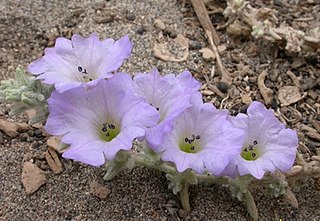
Datura is a genus of nine species of highly poisonous, vespertine-flowering plants belonging to the nightshade family (Solanaceae). They are commonly known as thornapples or jimsonweeds, but are also known as devil's trumpets or mad apple. Other English common names include moonflower, devil's weed, and hell's bells. All species of Datura are extremely poisonous and psychoactive, especially their seeds and flowers, which can cause respiratory depression, arrhythmias, fever, delirium, hallucinations, anticholinergic syndrome, psychosis, and death if taken internally.

The Mimosoideae are a traditional subfamily of trees, herbs, lianas, and shrubs in the pea family (Fabaceae) that mostly grow in tropical and subtropical climates. They are typically characterized by having radially symmetric flowers, with petals that are twice divided (valvate) in bud and with numerous showy, prominent stamens.

The Actinidiaceae are a small family of flowering plants. The family has three genera and about 360 species and is a member of the order Ericales.

Petunia is a genus of 20 species of flowering plants of South American origin. The popular flower of the same name derived its epithet from the French, which took the word pétun, 'tobacco', from a Tupi–Guarani language. A tender perennial, most of the varieties seen in gardens are hybrids.

Actaea, commonly called baneberry, bugbane and cohosh, is a genus of flowering plants of the family Ranunculaceae, native to subtropical, temperate and subarctic regions of Europe, Asia and North America.

Physalis is a genus of approximately 75 to 90 flowering plants in the nightshade family (Solanaceae), which are native to the Americas and Australasia. At least 46 species are endemic to Mexico. Cultivated and weedy species have been introduced worldwide. A defining feature of Physalis is a large, papery husk derived from the calyx, which partly or fully encloses the fruit. Many species bear edible fruit, and some species are cultivated.

Nolana is a genus of hard annual or perennial plants in the nightshade family. The genus is mostly native to Chile and Peru. Species in this genus, especially N. paradoxa, serve as a model system for studies on flower color.

Anogramma is a genus of ferns in the subfamily Pteridoideae of the family Pteridaceae. It contains about ten species, including:
Mark Wayne Chase is a US-born British botanist. He is noted for work in plant classification and evolution, and one of the instigators of the Angiosperm Phylogeny Group-classification for flowering plants which is partly based on DNA studies. In particular he has researched orchids, and currently investigates ploidy and hybridization in Nicotiana.

Scenella is an extinct genus of fossil invertebrate animal which is generally considered to be a mollusc; at various times it has been suggested that this genus belongs with the gastropods, the monoplacophorans, or the helcionellids, although no firm association with any of these classes has been established. An affinity with the hydrozoa has been considered, although some authors oppose this hypothesis. A gastropod affinity is defended on the basis of six pairs of internal muscle scars, whilst the serially-repeated nature of these scars suggests to other authors a monoplacophoran affinity. However the specimens showing this scarring have not been convincingly shown to belong to the genus Scenella. A similarity to the Ediacaran Ovatoscutum has also been drawn.

The tribe Sophoreae is one of the subdivisions of the plant family Fabaceae. Traditionally this tribe has been used as a wastebasket taxon to accommodate genera of Faboideae which exhibit actinomorphic, rather than zygomorphic floral symmetry and/or incompletely differentiated petals and free stamens. Various morphological and molecular analyses indicated that Sophoreae as traditionally circumscribed was polyphyletic. This led to a re-circumscription of Sophoreae, which resulted in the transfer of many genera to other tribes. This also necessitated the inclusion of two former tribes, Euchresteae and Thermopsideae, in the new definition of Sophoreae. Tribe Sophoreae, as currently circumscribed, consistently forms a monophyletic clade in molecular phylogenetic analyses. The Sophoreae arose 40.8 ± 2.4 million years ago.

Shortia is a small genus of subshrubs or perennial herbs in the family Diapensiaceae. There are five species, four in Asia and one in the Appalachian Mountains of eastern North America. They are found in mountainous areas, generally from 1,000–2,000 metres (3,300–6,600 ft) elevation. All have restricted ranges and are generally considered rare. Three of the species, S. galacifolia, S. soldanelloides, and S. uniflora are often cultivated. The genus was by Asa Gray named after botanist Charles Wilkins Short. In Gray's diary entry for April 8, 1839, he named the genus after Charles Wilkins Short because the plant was native to America in a region close to where Short lived, which was Kentucky. Short and Gray never met but they corresponded with one another frequently. Short never saw a live nor dried specimen of his namesake genus.

Capsicum is a genus of flowering plants in the nightshade family Solanaceae, native to the Americas, cultivated worldwide for their edible fruit, which are generally known as "peppers" or "capsicum". Sweet or bell peppers and some chili peppers belong to the Capsicum annuum species, making it the most cultivated species from the genus.

The Solanaceae, or the nightshades, are a family of flowering plants that ranges from annual and perennial herbs to vines, lianas, epiphytes, shrubs, and trees, and includes a number of agricultural crops, medicinal plants, spices, weeds, and ornamentals. Many members of the family contain potent alkaloids, and some are highly toxic, but many—including tomatoes, potatoes, eggplant, bell, and chili peppers—are used as food. The family belongs to the order Solanales, in the asterid group and class Magnoliopsida (dicotyledons). The Solanaceae consists of about 98 genera and some 2,700 species, with a great diversity of habitats, morphology and ecology.
Meso-Papilionoideae is a monophyletic clade of the flowering plant subfamily Faboideae that includes the majority of papilionoid legumes. This clade is consistently resolved in molecular phylogenies. It contains many agronomically important genera, including Arachis (peanut), Cicer (chickpea), Glycine (soybean), Medicago (alfalfa), Phaseolus, Trifolium (clover), Vicia (vetch), and Vigna.

Petunioideae is a subfamily within the family Solanaceae.
Schwenckia is a genus of flowering plants in the family Solanaceae, native to Central America and South America, and with one species, S. americana, a widespread weed in Africa. In the title of the generic description Linnaeus wrote "Schwenkia" but gave the binomial of the type species as Schwenckia americana, while quoting Dav. van Royen as the author.
Papuodendron is a genus of flowering plants belonging to the family Malvaceae. In 1946 Cyril Tenison White described its first species, Papuodendron lepidotum, which was discovered growing in 1944 in the Mandated Territory of New Guinea. Its native range is New Guinea.
Noah's wife is one of the four wives aboard Noah's Ark. While nameless in the Bible, apocryphal literature lists 103 variations of her name and personality.














